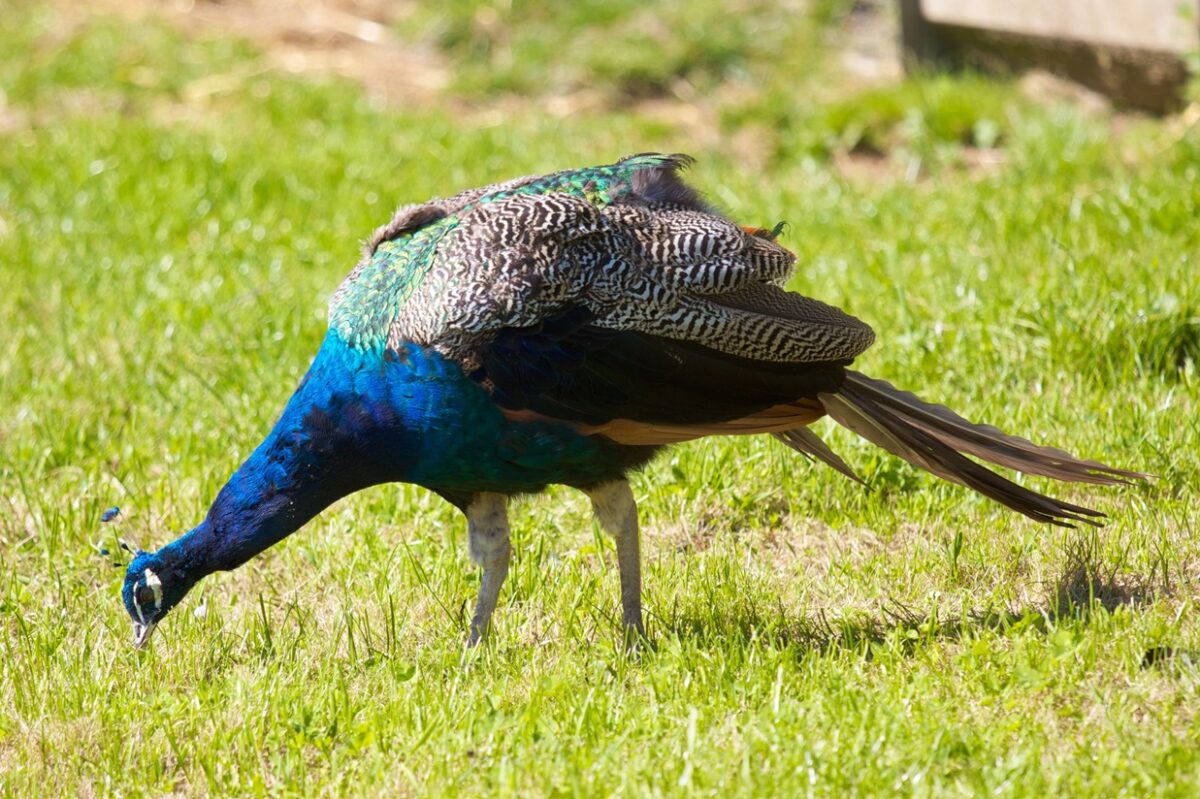Peacocks are large, colorful, tropical birds native to Southeast Asia and Africa. They are members of the Phasianidae family and are closely related to pheasants, turkeys, and chickens. The female peafowl is a peahen, while the male is called a peacock.
The male peacocks have a colorful train of feathers they fan out to attract attention from peahens. The plumage of Indian Peacocks is iridescent blue and green, while the Green Peafowl are green, gold, and black, and the Congo Peafowl are blue and black.
One of the three species of peafowl, the Green Peafowl, is endangered because of habitat loss, and their reduced populations only exist in parts of Vietnam and Cambodia. The Indian Peacock is the most widespread because they were introduced worldwide as a domesticated bird.
Peacocks are social birds and live in flocks called ostentations, where they communicate with loud, grating calls. They eat insects, reptiles, rodents, and plants, including fruits, vegetables, seeds, nuts, leaves, and flowers.

What Do Wild Peacocks Eat?
Wild peacocks are omnivores, and their diets vary widely, depending on where they live and what foods are seasonally available. Indian Peacocks are especially tolerant of different climates, living in tropical, subtropical, grassland, savannah, deciduous forests, and dry regions.
In their native ranges, Indian Peacocks eat beetles, termites, worms, lizards, small snakes, frogs, rodents, fruits, seeds, leaves, and flowers. In areas where human civilization has replaced natural habitats, they eat vegetables, food scraps, and crops.
Peacocks use their feet to scratch the ground to find insects and will chase small animals and capture them with their beaks. Because they have long necks, they can forage for plants well off the ground and even fly into trees to access fruits hanging too high to reach from the ground.
What do Domestic Peacocks Eat?
Peacocks were domesticated thousands of years ago, both for their beautiful feathers and for their meat. They were introduced to Europe more than two thousand years ago, and as Europeans explored and conquered the world, they brought peacocks with them.
Domestic peacocks live on every continent except Antarctica on farms, zoos, and parks, where they are ornamental livestock. In most of these places, feral peacocks that are descendants of escaped domestic birds thrive in human habitats.
Farmers usually feed their peacocks maize, millet, and commercial poultry feed, supplemented with fruits, vegetables, and insects. Domestic peacocks require a variety of foods to maintain their health and mimic the nutritional requirements of wild peacocks.
Feral peacocks typically eat crops in agricultural fields and vegetables in home gardens, which can cause damage and make them a nuisance to farmers. Some places discourage or fine people who intentionally feed feral peacocks because they are a problem in neighborhoods.
What Do Baby Peacocks Eat?
Peacocks, especially the domesticated ones, are prolific, producing up to eight eggs per clutch, and up to three clutches annually, depending on the climate and availability of food. Baby peacocks, called peachicks, can walk and run within hours of hatching.
Once hatched, baby peacocks leave the nest after the first day and follow their mother to learn how to find food. Wild baby peacocks stay with their mother for up to six months, but domesticated peacocks usually remain with their mother for no more than four months.
Wild baby peacocks learn what to eat by watching their mother. They typically consume worms, small lizards, insects, seeds, berries, leaves, flowers, and fruits. As they grow, they start to catch larger prey and can reach a wider variety of plants.
Domestic baby peacocks eat items with a lot of protein to boost their growth. These specially formulated diets include mealworms, snails, crickets, fruits, vegetables, seeds, and commercial poultry feed.
What Do Peacocks Drink?
Like most animals, peacocks need to drink water regularly and will drink from a variety of sources, including streams, ponds, puddles, dew, rainwater, and even birdbaths. Access to water is a critical consideration for these birds when they establish their territories.
While wild and feral peacocks typically live near readily accessible water sources, people can control nuisance peacocks with water. Farmers and homeowners can spray water at peacocks with a hose to discourage them from entering a garden or yard.
